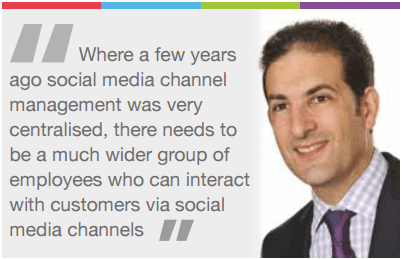How is social media changing the retail landscape? Mike Petrook, director of corporate affairs at The Institute of Customer Service, shares his insights with Jonathan Wright
What are different forms of social media for? From the perspective of individuals using Facebook, Pinterest or Twitter, while there will be nuances in different answers and the way people use different platforms, a common theme is the idea of connecting, of being part of a wider conversation. If an email exchange is roughly analogous a one-to-one conversation, social media interactions are closer to going to the pub or a café to meet friends.
For retailers, questions around the purpose of social media are tougher to answer. While it’s clear that customers are using Facebook, Twitter, Instagram and Google+ to interact with retailers, the image of a brand placing itself in the middle of a fast-moving pub conversation is, with the potential for gaffes and misjudgments, one that’s likely to make any marketing director at the very least slightly nervous.
However, as recent research from the Institute of Customer Service makes clear, retailers can’t do whatever the digital equivalent is of staying at home and avoiding these conversations. First and foremost, Service Goes Social: How Organisations Can Deliver Customer Service Through Social Media, based on the views of 2,195 consumers and a dozen in-depth interviews with senior customer service executives, reveals the growing importance of social media as a channel.
“Increasingly, social media is pertinent and one of the major reasons for that is because, from the customer’s point of view, it’s all about rapid response and it’s public as well,” says Mike Petrook, director of corporate affairs at The Institute of Customer Service.
Challenging assumptions
If this idea of a public forum brings forth images of customers deciding to make complaints and grumbles available to the wider world, that’s not actually the main story here.
“One of the things the research showed that was particularly intriguing is that most people’s assumption is that you or I would turn to social media in the event of having a complaint, but that’s certainly not the case with the research,” says Petrook. “Yes, it’s true that 26% of people use social media to make a complaint but far more, 42%, also use social media to like or follow organisations online.” In addition, the research shows that 39% of respondents “use social media to give feedback, positive or negative”.
The research challenges other assumptions. In particular, one idea often expressed about social media is that it’s for young people, that older customers don’t get it, yet it turns out that customers aged 45-54 are the most likely to share their experiences of an organisation through social media.
There are more surprises in the figures too. “What I thought was quite interesting was that if you look at the 55-64 age group, or even 65-plus, there’s quite a considerable amount of people who use the likes of Twitter,” says Petrook. “So [the figure for] 55-64 was 27% of them use Twitter to communicate with organisations. If you drop that down to say the 25-34-year-old bracket, that figure is 47%, so yes there is a sizeable difference, but we’re talking about just over one in four of the 55-plus age group turning to social media.”
It’s worth pausing to consider that we’re talking about Twitter here, a company that’s recently been in the news because it’s failing to drive revenues from its 300m-plus customers and its user-base growth is flattening. The now firmly mainstream Facebook cuts across different age groups even more impressively, with more than 90% of people surveyed using the platform whether they’re aged between 18 and 24, 35 and 44, or 54 and 65.
Joining the conversation
Looking at these figures in the round, the key points are that social media is not going to go away and that, while it might be used in different ways by different demographics, it is most definitely being used across demographics. To restate the question we began with (what are different forms of social media for?) one answer is to reply that it’s the wrong question to ask. In a world where customers regularly use Facebook, Twitter, Pinterest and other social media platforms, a more pertinent question is how do retailers best join these pub and café conversations?
Drilling down further, and to adapt the title of the Institute of Customer Service’s report, we might also ask how do retailers use social media to deliver great customer service? Do retailers need to learn new techniques, or is good customer service delivered via social media much the same as good customer service delivered in other channels?
“There are a couple of answers there,” says Petrook. “The first [relates to the idea] that customers want choice. Sometimes they’re going to want to talk to somebody over the phone, sometimes they want to see the whites of their eyes, and sometimes they want to engage online. But what that means is, in terms of good customer service, organisations need to develop multi-skilled people who can operate across different channels.”
“The second thing is it’s critical that, as social media becomes an increasingly common way for customers to contact and deal with organisations, how companies manage these social media channels is important. What I’m saying there is, where a few years ago social media channel management was very centralised, there needs to be a much wider group of employees who can interact with customers via social media channels. That means enabling them to do that, it means empowering them to do that, and it means giving them the skills to do it as well.”
Petrook adds that he thinks employees need to be “engaged” as well as “empowered” when it comes to dealing with social media, “and that means building a culture within an organisation to let that happen”. Interestingly, there are more than a few echoes with Majestic Wine’s approach to social media (see our interview on page 20). Yet while it might be easy for a specialist retailer, a company selling wine – or telescopes, electric guitars or posh cheese for that matter – to let expert staff loose on social media, this may not be such a comfortable proposition for retailers aiming at the mass market.
Social and the high street
That’s not the same as saying it can’t be done. M&S is now investing around a fifth of its media budget in social media, and while the company’s focus is primarily on content and storytelling, as opposed to customer service per se, its developing strategy is a clear recognition that business conditions are changing – and will continue to change.
“There are some future challenges with social media that I think need to be explored, and that is does social media provide a genuine chance for co-creation where organisations are effectively treating customers as part of the equation in developing new products and services?” says Petrook.
This may be a new area for retailers, but a company such as Lego has long looked at ways to get existing customers – fans is perhaps a more
apposite word – involved in product development. Head to ideas.lego.com, for instance, and you’ll find customer ideas vying for support and feedback, such as a proposal for the company to produce an RMS Titanic kit.
It all adds up to a landscape where consumers will increasingly want retailers to be more transparent, to opt for “a dialogue-type approach, as opposed to a monologue”. Petrook adds: “The days of customers just saying to their customers, ‘This is what we offer,’ are gone. It’s much more about: ‘This is what we offer, does it work for you? How can we develop it with you?’”
The relationship economy
The report calls this a shift to a “relationship economy”, a shift that might have some surprisingly far-reaching effects. Take a transaction as simple as selling a customer a pint of milk. Under a so-called “transactional economy” model, this is straightforward. A customer walks into a store and, cash on the counter, purchases a pint of milk.
Now consider how this might work in a relationship economy model. “What organisations are looking to do is say, ‘OK, if you want a pint of milk, what is it that you want it for?’ explains Petrook. “‘Are you making an omelette? Or is it that you want to eat a bowl of cereal?’ So it’s to gain an understanding of what it is that you as the customer is trying to achieve, so that they can help you do that, and that you recognise that as the customer and therefore keep going back because the bottom line is all about if you have a good relationship with somebody, you will keep talking to them.”
Even the supermarkets, it’s probably fair to say, are a way off discovering how customers might use specific pints of milk, but Petrook’s example illustrates the direction of travel. “Organisations need to build their capability to generate insight from the social media activity that they undertake,” he says. “It’s about treating social media as social intelligence and then critically, and this really is critical, acting on it. It’s all very well knowing something, but what are they doing to improve the customer experience from there?”
Customer service winners
Which companies are providing the best customer service with in the UK? While the bad news is that, according to The Institute of Customer Service’s January 2015 UK Customer Satisfaction Index report, “UK customers are now, on average, less satisfied with the service they receive than at any point since July 2010,” the retail sector performs best among the 13 sectors monitored. Non-food retail had an overall value of 81.4 (out of 100), while food retail was at 79.6. In contrast the utilities’ value was 70.9. In addition, four of the top five performers – John Lewis, Amazon, First Direct, Ocado and M&S (food) – were retailers.
As we make the transition into an omnichannel, relationship economy model, this is particularly important because those companies performing best in this index now have a clear advantage going forward.
“The evidence that we have shows that there is a tangible link between how businesses have developed strong customer service and their increasing revenue,” says Mike Petrook. “For us, in our UK Customer Satisfaction Index, the highest-scoring organisations do show increases in revenue, and particularly if we look at the retail food sector, there is a consistent link between service levels and increasing market share.”







